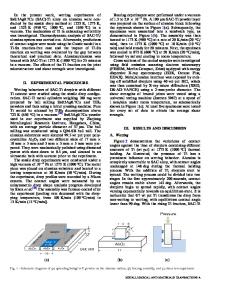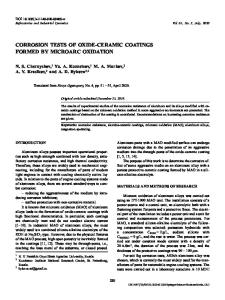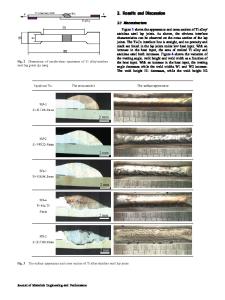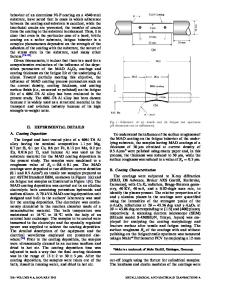Fabrication of dense alumina layer on Ti alloy hybrid by cold metal transfer and micro-arc oxidation methods
- PDF / 428,962 Bytes
- 10 Pages / 584.957 x 782.986 pts Page_size
- 33 Downloads / 201 Views
Ganapathiyankavu Pisharam Rajeev Department of Metallurgical and Materials Engineering, Materials Joining Laboratory, Indian Institute of Technology Madras, Chennai 600036, India
Hiroaki Takadama Department of Biomedical Sciences, College of Life & Health Sciences, Chubu University, Kasugai, Aichi 487-8501, Japan
Srinivasa Rao Bakshi Department of Metallurgical and Materials Engineering, Materials Joining Laboratory, Indian Institute of Technology Madras, Chennai 600036, India (Received 2 January 2017; accepted 13 March 2017)
Recent advances in alumina ceramics are focused toward innovative processing routes to improve their mechanical reliability while retaining their superior wear resistance, which might be possible if a thin layer of dense alumina can be formed on a metallic substrate such as Ti–6Al–4V with high mechanical strength. For this purpose, we propose a new two-step process in which a dense layer of Al deposited on the Ti alloy by cold metal transfer method, formed a dense Al3Ti gradient reaction layer at their interface to improve adhesion in a single step. Subsequent micro-arc oxidation treatment transformed Al layer to a graded alumina layer in which c-alumina decreased and a-alumina increased with increasing depth. Abrasion of outer regions revealed underlying pure a-alumina regions with high Vickers hardness matching with that of sintered alumina. The designed alumina/Ti alloy hybrid can be a potential candidate for wear resistance applications. I. INTRODUCTION
Over more than 30 years, monolithic alumina is being used as the bearing component in hip prosthetic devices due to its superior wear resistance, chemical durability, and bio-inertness,1,2 but it is liable to fracture. To improve its reliability, stabilized zirconia3 or zirconia– alumina composites4,5 with high fracture toughness have been fabricated. However, the possibility of fracture of these composite ceramics cannot be eliminated. These disadvantages have spurred exploration of thin zirconia ceramic layers on metallic substrates as an alternative to monolithic ceramics. For this purpose, a ;5 lm thick layer of zirconia was formed on the surface of a Zr–2.5% Nb alloy using heat treatment at 500 °C.6 This hybrid design of the zirconia layer on the Zr–Nb alloy has been successfully applied to a femoral head, commercialized as Oxinium™ (Smith & Nephew, Memphis, Tennessee). However, some reports have revealed the extensive damage and delamination of zirconia layer during bearing operations.7,8 In some cases, ultra-hard ceramic layers of diamond-like carbon9,10 or titanium nitride11 have been Contributing Editor: Eugene Medvedovski a) Address all correspondence to this author. e-mail: [email protected], [email protected] DOI: 10.1557/jmr.2017.105
fabricated on Ti–6Al–4V alloy. However, both of these layers showed poor adhesion with the substrate and released wear debris enhanced third body wear which has limited their use for long term structural applications in industry.12,13 In this perspective, we previously proposed a new hyb
Data Loading...











